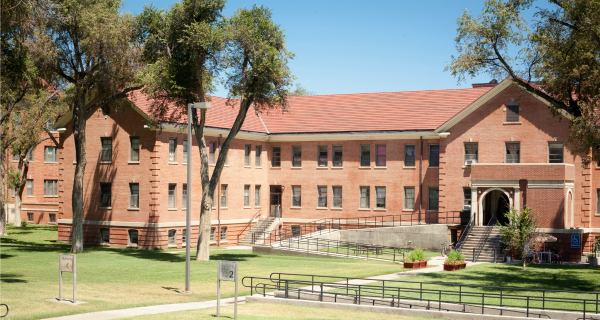
Before I left for a month-long writing residency at Fort Lyon Supportive Residential Community, my wisest friends told me that I would learn more from the residents than they would learn from me. Indeed, my first glimpse of the open green quad and the red brick buildings with their columns and arches reminded me of a college campus, the physical embodiment of education and a familiar environment to me.
But these historic buildings have housed armies, veterans sick with tuberculosis, prison inmates, and now recovering alcoholics and addicts who have been homeless and don’t want to be again. None of those situations is familiar to me, and so my first day at Fort Lyon was spent in mild panic. I was outside of my comfort zone, away from my loved ones, my geographic sense of home, my normal routine. I questioned why I’d ever decided to come.
And then it struck me how every single resident here has experienced the displacement of arriving at Fort Lyon. They’d all made the decision to come, but without any certainty of when their stay would end or how. I had a home to return to, and I knew the date I’d be doing so. I moved rapidly through my fears then and set to the business of teaching my creative writing classes and the greater task of learning whatever I needed to learn.
One woman took me as a guest to my first AA meeting. Another resident shared his portfolio of artwork and first sketches of a comic featuring a goat-blood-sucking chupacabra that he hoped would be as lovable as Warner Brothers’ Tasmanian Devil. I rode the weekly school bus to Wal-Mart in La Junta, an outing that turns everyone into exuberant, rowdy children. I joined the perpetual trash talk between Broncos fans and an unfortunately loud Raiders contingency. I also grieved when residents left after violating program rules, put on the bus to an uncertain future, their emptied rooms a reminder that this place is ultimately one of transition and not a forever hideaway.
One morning at breakfast a man who’d silently handed me a Dum-Dum sucker in my first week finally spoke to me. He said, “You’ve come to the most chaotic place on earth.”
I paused over my coffee, thinking of the faculty strike at my university back home, and replied, “I don’t see it that way. I see people who’ve gotten away from the external chaos of their lives and are now finding a way to re-order the inner chaos.”
“Say more,” he said, hands dug deep in his army jacket.
I’d only had a few sips of coffee, but I tried for a coherent explanation. “Most people out there pretend the inner chaos doesn’t exist, and when they have good jobs and live in nice homes, it’s easy to pretend. But if you can’t or won’t see problems, you can’t work on them.”
I was surprised, again, at how easily I could talk with so many of the people at Fort Lyon. There was very little posturing or bluffing or secret measuring, and I didn’t feel judged or on guard.
The man responded, “So say a couple is not getting along, arguing and all that, and they send only one of them off to therapy or treatment because he’s the problem. What happens?”
I had no clue why we were talking suddenly about couples counseling issues, but I played along. “It probably doesn’t work to heal that relationship. If they’re not both working on the problems, their own and those between them, the problems repeat themselves.”
He looked in my eyes for a long moment then nodded slowly. “Good for you,” he said. “I’m glad you’re here. Have a good day.”
I kept drinking my coffee, perplexed, wondering if he were telling me something about his own relationship back home. As I mentally reviewed the conversation, I suddenly understood and wanted to chase him down and tell him so. He wasn’t talking about a personal relationship, but about the relationship between the people inside Fort Lyon and the “normies” (people who aren’t addicts or alcoholics) outside. We can send people away to “fix their problems,” but the problems don’t start and end only inside that individual, and to behave as if they do is to ignore all the ways we scapegoat and support a social order that treats the people with the least power as “problems” instead of suffering humans in relation with other suffering humans.
The average age of the residents at Fort Lyon is somewhere between 47 and 52, a demographic I’m fast approaching. When I spoke to another resident about whether she felt what happened in her life could happen to anyone, she said, “No. There are a lot of ways you could lose a home and be on the street. But you’re not an addict. And that’s an important difference. The way my addiction created my homelessness and vice versa is what I’m here to understand and work through.”
I am still learning. The residents of Fort Lyon are still learning. And that openness to change—in all of us—helps sustain my hope in our future.
Chauna Craig was our fall 2016 Fort Lyon Writer-in-Residence. Her short story collection, The Widow’s Guide to Edible Mushrooms, was published by Queen’s Ferry Press in 2016. Her awards include honorable mentions in the Pushcart Prize anthology and in Best American Essays and the Sandra Brown Short Fiction Award. She was a waiter-scholar at Bread Loaf Writers’ Conference and has been awarded fellowships to the Vermont Studio Center, Hedgebrook, and Virginia Center for the Creative Arts. She teaches creative writing at Indiana University of Pennsylvania.

